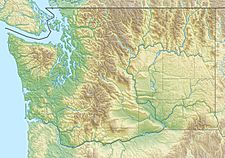Stuart Glacier facts for kids
Quick facts for kids Stuart Glacier |
|
|---|---|
| Type | Alpine glacier |
| Location | Wenatchee National Forest, Chelan County, Washington, U.S. |
| Coordinates | 47°28′45″N 120°54′06″W / 47.47917°N 120.90167°W |
| Length | .20 mi (0.32 km) |
| Terminus | Icefall |
| Status | Retreating |
Stuart Glacier is a large body of ice located in the Wenatchee National Forest in the state of Washington, U.S.. It lies on the north side of a tall mountain called Mount Stuart. This glacier is part of the Alpine Lakes Wilderness, a special protected area.
Contents
What is Stuart Glacier?
Stuart Glacier is an alpine glacier, also known as a mountain glacier. These glaciers form in high mountain valleys and move slowly downhill. Stuart Glacier is about .20 mi (0.32 km) (0.32 kilometers) long. At its widest point, it measures about .25 mi (0.40 km) (0.40 kilometers) across.
How Does Stuart Glacier Move?
This glacier starts high up at about 7,400 ft (2,300 m) (2,255 meters) and flows down to about 6,400 ft (2,000 m) (1,950 meters). At its lower end, it forms an icefall. An icefall is like a frozen waterfall where the ice breaks apart as it flows over steep ground.
Stuart Glacier's Neighbors
Not far from Stuart Glacier, less than .50 mi (0.80 km) (0.80 kilometers) to the southeast, you can find another glacier called Sherpa Glacier. Both glaciers are important parts of the mountain environment.
Why Are Glaciers Important?
Glaciers like Stuart Glacier are huge masses of ice that form over many years from packed snow. They are important for several reasons:
- Freshwater Source: As glaciers melt, they provide fresh water to rivers and streams. This water is used by people, animals, and plants.
- Climate Clues: Glaciers can tell us a lot about Earth's past climate. Scientists study ice cores from glaciers to understand how temperatures have changed over thousands of years.
- Ecosystems: Glaciers create unique habitats for certain plants and animals. The cold meltwater supports special ecosystems.
Glaciers and Climate Change
Many glaciers around the world, including Stuart Glacier, are currently retreating. This means they are getting smaller. Scientists believe this is happening because of a warming climate. Studying glaciers helps us understand the effects of climate change on our planet.


